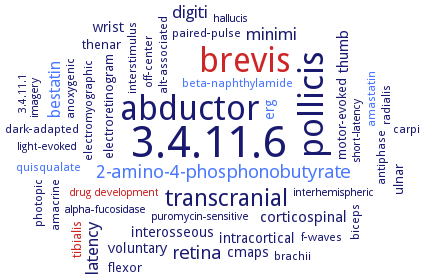3.4.11.6: aminopeptidase B
This is an abbreviated version!
For detailed information about aminopeptidase B, go to the full flat file.

Word Map on EC 3.4.11.6 
-
3.4.11.6
-
brevis
-
pollicis
-
abductor
-
transcranial
-
retina
-
2-amino-4-phosphonobutyrate
-
minimi
-
digiti
-
latency
-
bestatin
-
thumb
-
corticospinal
-
erg
-
interosseous
-
cmaps
-
intracortical
-
voluntary
-
wrist
-
thenar
-
tibialis
-
ulnar
-
electroretinogram
-
motor-evoked
-
flexor
-
radialis
-
interstimulus
-
off-center
-
f-waves
-
antiphase
-
amacrine
-
dark-adapted
-
biceps
-
paired-pulse
-
beta-naphthylamide
-
alt-associated
-
carpi
-
brachii
-
anoxygenic
-
electromyographic
-
quisqualate
-
photopic
-
amastatin
-
short-latency
-
drug development
-
3.4.11.1
-
interhemispheric
-
alpha-fucosidase
-
hallucis
-
light-evoked
-
puromycin-sensitive
-
imagery
- 3.4.11.6
- brevis
-
pollicis
-
abductor
-
transcranial
- retina
- 2-amino-4-phosphonobutyrate
-
minimi
-
digiti
-
latency
- bestatin
-
thumb
-
corticospinal
- erg
-
interosseous
-
cmaps
-
intracortical
-
voluntary
-
wrist
-
thenar
- tibialis
-
ulnar
-
electroretinogram
-
motor-evoked
-
flexor
-
radialis
-
interstimulus
-
off-center
-
f-waves
-
antiphase
-
amacrine
-
dark-adapted
-
biceps
-
paired-pulse
- beta-naphthylamide
-
alt-associated
-
carpi
-
brachii
-
anoxygenic
-
electromyographic
- quisqualate
-
photopic
- amastatin
-
short-latency
- drug development
-
3.4.11.1
-
interhemispheric
- alpha-fucosidase
-
hallucis
-
light-evoked
-
puromycin-sensitive
-
imagery
Reaction
release of N-terminal Arg and Lys from oligopeptides when P1' is not Pro. Also acts on arylamides of Arg and Lys =
Synonyms
AAP, ACE2, Aminopeptidase, aminopeptidase B, aminopeptidase, arginine, aminopeptidase-B, Ap-B, APB, Arg-AP, Arg/Lys aminopeptidase, ArgAP, arginine aminopeptidase, arginine-aminopeptidase, arginyl aminopeptidase, arginyl peptidase, arylamidase, arylamidase II, BSAP, chloride-dependent-basic aminopeptidase, Cl--activated arginine aminopeptidase, Cl--activated arinine aminopeptidase, Co(II)-Ap-B, ColAP, cold-active aminopeptidase, Cu(II)-Ap-B, cytosol aminopeptidase, cytosol aminopeptidase IV, DAP BII, dipeptidyl aminopeptidase BII, double-zinc aminopeptidase, EC 3.4.13.6, KAP, L-arginine aminopeptidase, L-RAP, LAPase, leukocyte-derived arginine aminopeptidase, LRAP, lysine-specific aminopeptidase, minopeptidase, More, protease IV, pumAPE, RAP


 results (
results ( results (
results ( top
top






